Perhaps you may be thinking of forfeiting your lease to deal with a problematic tenant, or maybe your landlord is taking steps toward ejecting you from the leased premises? It is essential at this point for either party to understand the basics of forfeiture of a lease, to prevent the tampering of rights, and to know how to seek legal advice.
First, forfeiture is a landlord’s right to terminate the lease of a tenant based on the occurrence of certain events. It is an absolute remedy available to management companies and landlords in both commercial and residential properties. It is undoubtedly a vital tool which must be carefully managed because the right to forfeiture of a lease is indeed not automatic.
The Implications of Forfeiting the Lease
As stated above, forfeiture of a contract is an exclusive option for a landlord seeking to implement his right against his defaulting tenants. This means that forfeiture proceedings must be strictly followed to avoid any wrongful forfeiture and consequently, potential compensation claims. Even when a tenant breaches any covenant stipulated in the lease, the aspect of seizure may not necessarily be the best remedy for the landlord.
The landlord should consider the charges of forfeiture, directly and indirectly, in contrast with the benefits he may enjoy if the breach by his tenant is resolved and he allows such tenant to stay on. Inevitable professional costs compound during forfeiture proceedings. Other fees such as fixing the environment for re-letting, utilities, and maintenance, may affect the landlord negatively if he impulsively opts for the forfeiture of the lease.
Alternatives to the Right to Forfeiture of a Lease

If you need choices other than enforcing the right to seizure, they include requesting for damages against the erring tenant and negotiating on an arrangement for your tenant to pay rent on a basis different from that stipulated in the lease. Also, you may make claims against the guarantors for the default in rent payment. These measures will provide you assistance with problems of cash flow. Although in certain circumstances there may be grounds for waiving forfeiture of lease rights, this should be done with utmost caution and advice from experts.
Waiving Forfeiture of Lease Right
Notwithstanding these costs and alternatives, the dangers of waiving your forfeiture rights should also be considered. It is vital that a landlord does not unintentionally forfeit this right as it may have dire consequences if he does so. For instance, a waiver may happen where a landlord communicates his knowledge of a covenant breach by the tenant and agrees to the continuation of the lease.
Where forfeiture proceedings occur in this case, the landlord is liable to a wrongful forfeiture. Subsequently, the tenant will have a claim to damages.
Forfeiture Clause
The forfeiture clause allows for the early termination of a lease by the landlord if the tenant breaches the covenant to pay rent. For residential premises, the landlord needs to obtain an order from the court before he can terminate the lease.
Forfeiture clauses help ensure the proper incentive of tenants in complying with the conditions. Moreover, not just the tenants are affected by the forfeiture of the lease.
Forfeiture for Default in Rent Payment

A landlord is not required to present a notice under the Law of Property Act 1925 (Section 146) before forfeiture of a lease on the grounds of default in rent payment. However, it is advisable for the landlord to check the tenancy agreement terms regularly. This is to determine whether it is mandated to pay rent by a formal demand, or not.
When the above is complied with and ascertained (if necessary or subject to further restrictions by statutes), there are majorly two available methods to exercising the right to forfeiture of the lease. They are peaceable re-entry, that is, actual re-entry; and court proceedings, also known as notional re-entry.
Peaceable Re-entry
Peaceable re-entry is where the landlord re-enters the property physically and brings the lease to an abrupt end without the requirement of forfeiture proceedings in a court. As regards residential premises, this process is done where there is no more extended occupation by the tenant.
For commercial premises, on the other hand, the tenant may still be occupying the property. Peaceable re-entry comes in where there is nobody at the premises physically to oppose the readmission as at the period of forfeiture.
Court Proceedings

Court proceedings are applied to enforce the right to forfeiture of lease where there is still an occupation of the property by the tenant, that is, in residential premises. It also applies to commercial premises where there is 24-hour security on the property. If for more tactical reasons, the landlord may prefer to effect forfeiture rights by court proceedings other than by peaceable re-entry.
The landlord is capable of notionally reentering the premises by starting possession proceedings that are based on valid grounds of forfeiture. This forfeiture takes effect from the service point and not at the issue of the forfeiture proceedings.
The above rules are also applicable to a tenant’s non-payment of service rates, where the service costs are reserved in the form of rent. However, there are specific rules concerning the non-payment of service rates for residential leases.
Forfeiture of Breaches Other Than a Default in Rent Payment
For other causes of the forfeiture action, the landlord should provide notice of Section 146 before forfeiture of lease, either by court proceedings or a peaceable re-entry. This notice must constitute the breach in question and ensure that the tenant is required to remedy the violation.
For Security Company Essex – Call: 01277 376 080
Furthermore, the notice should entail the specified compensation required of the tenant to the landlord within a reasonable period. Even where the breach may not be remedied, the court in appropriate circumstances may make a relief order. The tenant’s application propels this order.
Conclusion
Professionals such as MEC Security can further explain the basics of forfeiture of a lease. Some aspects of the forfeiture clause and proceedings may be complicated, and you need expert advice to scale through. It is essential to get it right and avoid mistakes that may be detrimental in the long run.


 Call us:
Call us:
 Email us:
Email us:








